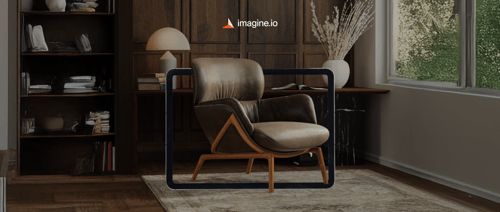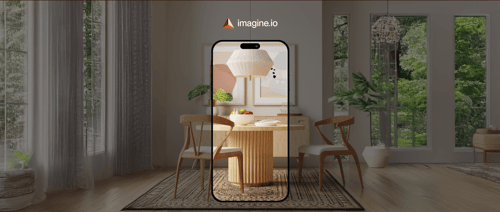Cloud-based 3D visuals revolutionize textile eCommerce by offering realistic product experiences. These immersive technologies enhance customer confidence, reduce return rates, and drive sales growth.
Quick Listen:
Imagine a shopper in Los Angeles browsing a website for a new couch. The screen shows a velvet sectional, but the flat image fails to capture how the fabric shimmers or drapes. Uncertain, they close the tab. This scenario, all too common in textile eCommerce, underscores a critical challenge: conveying the tactile essence of fabrics online. Cloud-based 3D visualization, pioneered by platforms like imagine.io, is revolutionizing how textile brands from bedding giants to boutique apparel engage customers. In a post-COVID digital commerce surge, these tools deliver photorealistic visuals that make fabrics feel tangible, driving buyer confidence across markets like New York, Chicago, and Canada.
The stakes are high. Textile businesses, both direct-to-consumer and B2B, face pressure to deliver immersive experiences that rival in-store shopping. With cloud-based 3D tools, brands can render fabrics with such precision that shoppers practically feel the weave. Powered by AI and scalable cloud platforms, these solutions are slashing costs, accelerating workflows, and redefining eCommerce for companies like Ruggable and SertaSimmons. The result? A digital storefront that's as compelling as a physical one.
Trends Reshaping Textile Visualization
The textile industry is riding a wave of innovation, with 3D visualization at its crest. Shoppers demand more than static images they want to see how linen ripples, silk gleams, or cotton absorbs color. A recent report projects the global 3D avatar solution market, valued at $183.48 million in 2024, to reach $1,234.37 million by 2031, growing at a 31.3% CAGR through 2025–2031, driven by eCommerce's embrace of AI, machine learning, and real-time rendering. This growth fuels demand for WebAR, virtual try-ons, and 360° product viewers, especially among mobile-first shoppers in regions like Dallas and Las Vegas.
Textile brands are responding. Direct-to-consumer companies are launching customization tools, letting shoppers tweak bedding colors or upholstery fabrics in real time. B2B players, meanwhile, are building virtual showrooms to showcase collections without physical samples. imagine.io's AI-enhanced rendering engine excels here, producing photorealistic visuals that capture fabric sheen, folds, and draping with stunning accuracy, meeting the needs of brands across the United States and beyond.
Customization and Immersion
Customization is king in today's eCommerce landscape. Shoppers want to personalize everything, from sofa upholstery to curtain textures. Cloud-based 3D tools enable this, offering interactive experiences that let customers visualize their choices instantly. For mobile-first markets, WebAR integrations where shoppers can project a rug or throw onto their living room via smartphone are gaining traction. imagine.io's platform supports these trends, delivering scalable, high-fidelity visuals that keep brands competitive.
Real-World Impact: Success in Action
The power of 3D visualization shines in real-world applications. A home textile brand, serving markets from Austin to High Point, used imagine.io to scale global product listings without physical inventory, cutting logistics costs dramatically. An apparel brand launching a new line leveraged on-model 3D visuals, reducing sample production costs by 60%. Retailers like King Koil are seeing similar results, using 3D to showcase complex catalogs with ease.
Interior décor brands are also thriving. One retailer introduced an interactive sofa configurator, allowing customers to swap fabrics and colors on the fly. The outcome? Longer dwell times on product pages and fewer returns, as shoppers could visualize their purchases accurately. imagine.io's ability to handle bulk SKU rendering and fabric-specific material physics makes these successes scalable, empowering brands to manage high-volume catalogs effortlessly.
Case Study: Scaling with Speed
Consider a DTC textile brand expanding into Canada. Traditionally, scaling their catalog would require costly photoshoots and weeks of post-production. With imagine.io's cloud platform, they uploaded 3D models and generated thousands of photorealistic assets in minutes. This speed, paired with unlimited image outputs under imagine.io's subscription model, addresses a key objection: the complexity of ongoing subscriptions versus project-based work. The result was a seamless global rollout, with visuals that maintained consistency across LinkedIn campaigns and eCommerce platforms.
Overcoming eCommerce Hurdles
Textile eCommerce faces stubborn challenges. Online, it's hard to convey a fabric's texture or scale think a rug that looks plush but arrives flat. Traditional photoshoots are slow and expensive, often delaying launches. Worst of all, visual misrepresentations fuel return rates, with some retailers reporting up to 30% returns due to mismatched expectations.
Cloud-based 3D visualization tackles these head-on. By eliminating physical photoshoots, brands create assets in minutes, not weeks. imagine.io ensures textures look consistent across devices, so a silk curtain appears as luxurious on a phone as on a desktop. Real-time updates enable rapid collection launches, while photorealistic rendering aligns customer expectations with reality, cutting returns. For brands like KitchenAid, this means faster, more cost-effective market entry.
Addressing Objections
Prospects often hesitate, citing ongoing subscription costs or pricing complexity compared to competitor's project-based models. imagine.io counters this with unmatched value: its all-in-one platform delivers images, videos, 360° views, and configurators, unlike competitors focused on single formats. Studies show eCommerce leaders can't distinguish imagine.io's visuals from real photoshoots, proving its quality rivals traditional methods while offering unmatched scale.
Driving Business Value
The numbers are striking. A market analysis forecasts the 3D fashion design software market to grow from $2.4 billion in 2024 to $6.8 billion by 2033, with a 10.9% CAGR. In the U.S., 61% of fashion houses use virtual sampling, 58% adopt avatar-based fitting, and 53% leverage cloud integration to shrink design-to-shelf timelines. Virtual try-ons, a priority for 51% of brands, are boosting eCommerce engagement.
For textile brands, this means faster launches, higher conversions, and lower returns. imagine.io's no-code platform delivers template-driven visuals, letting companies like Kohler hit markets quickly. Interactive product pages increase dwell time, while accurate visuals reduce returns by ensuring customers “see” fabrics clearly. For global players, cloud accessibility ensures consistency across channels, from Instagram to marketplaces.
The Future of 3D Textiles
The horizon is bright. AI-generated fabric variants are streamlining design, while real-time lighting simulation enhances realism. Behavioral analytics could enable hyper-personalized visuals, tailoring experiences to individual shoppers. B2B textile sourcing is shifting to virtual showrooms, letting buyers in Las Vegas or Dallas explore collections digitally. Sustainability is another win: digital sampling reduces waste, aligning with the values of brands like PepsiCo.
imagine.io is leading the charge, offering tools that blend scale, speed, and precision. Its cloud platform supports the industry's shift toward digital-first strategies, making it a cornerstone for textile innovation.
A New Era for Textile eCommerce
Cloud-based 3D visualization is more than a tool it's a transformation. By cutting costs, accelerating launches, and delivering visuals that captivate, platforms like imagine.io are redefining textile eCommerce. As one industry expert notes, “The future of textiles lives in the cloud, where creativity meets efficiency.” From Chicago to Canada, brands embracing 3D are crafting a new narrative: one of innovation, engagement, and limitless potential. The question isn't whether to adopt 3D it's how soon you can start.
Frequently Asked Questions
How do cloud-based 3D visuals improve textile eCommerce conversion rates?
Cloud-based 3D visualization significantly boosts textile eCommerce conversions by delivering photorealistic fabric renderings that make materials feel tangible online. These interactive tools allow shoppers to see how fabrics shimmer, drape, and move in real-time, building buyer confidence and reducing the uncertainty that causes cart abandonment. Studies show that accurate 3D visuals can reduce return rates by up to 30% while increasing dwell time on product pages, as customers can visualize purchases more accurately than with traditional flat images.
Can cloud-based 3D tools handle complex textile customization for eCommerce?
Yes, modern cloud-based 3D platforms excel at handling complex textile customization, offering interactive configurators that let customers swap fabrics, colors, and textures in real-time. These tools support everything from sofa upholstery customization to bedding color variations, with AI-enhanced rendering engines that capture fabric-specific properties like sheen, folds, and draping with stunning accuracy. The scalable cloud infrastructure can manage high-volume catalogs and bulk SKU rendering, making customization accessible for both direct-to-consumer brands and B2B textile companies.
What are the cost benefits of using 3D visualization versus traditional textile photography?
3D visualization platforms like imagine.io eliminate the need for expensive physical photoshoots, reducing sample production costs by up to 60% for textile brands. Instead of weeks of post-production work, companies can generate thousands of photorealistic assets in minutes using cloud-based rendering. This speed advantage allows brands to scale globally without costly logistics, create unlimited image variations under subscription models, and launch new collections faster than traditional photography methods.
Disclaimer: The above helpful resources content contains personal opinions and experiences. The information provided is for general knowledge and does not constitute professional advice.
You may also be interested in: imagine.io | Award Winning 3D + AI Product Visualization
Struggling with expensive, outdated product visuals that slow down your creative process and stunt eCommerce growth? imagine.io's AI-powered platform empowers furniture, home décor, and textile brands to effortlessly produce striking 3D images, immersive videos, AR experiences, and interactive configurators. Cut production costs up to 70%, boost conversions 5X, speed up prototyping, and supercharge your online sales. Ready to elevate your product visuals and captivate customers? Book a demo with imagine.io today!
Powered by flareAI.co




.png?width=500&name=How%20to%20Add%20a%203D%20Product%20Configurator%20to%20Your%20WordPress%20Website%20(Complete%20B2B%20Guide).png)
















%20(1).png?width=500&name=Why%20Exploded%20Mattress%20Views%20Matter%20(And%20How%20to%20Generate%20Them)%20(1).png)
.png?width=500&name=Best%20Shopify%20Product%20Configurator_%20How%20to%20Choose%20the%20Right%20One%20(2).png)
.png?width=500&name=Why%20Exploded%20Mattress%20Views%20Matter%20(And%20How%20to%20Generate%20Them).png)



.png?width=500&name=Best%20Shopify%20Product%20Configurator_%20How%20to%20Choose%20the%20Right%20One%20(1).png)







.png?width=500&name=How%203D%20Rendering%20Can%20Make%20or%20Break%20Your%20Industrial%20Design%20Pitch%20(1).png)








%20with%20Digital%20Twins%20and%203D%20Visualization.png?width=500&name=Optimizing%20Your%20Digital%20Asset%20Management%20(DAM)%20with%20Digital%20Twins%20and%203D%20Visualization.png)




.png?width=500&name=Styling%20Home%20Decor%20for%202025_%20From%20Global%20Influences%20to%20Playful%20Personalization%20(1).png)
